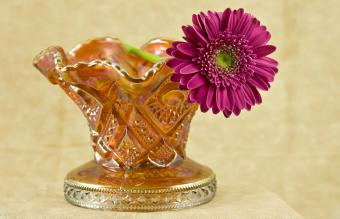
If you're like most of us, your china cabinet has plenty of sparkling glassware in all different patterns, colors, shapes, and sizes. When it comes to vintage pressed glass patterns, identification is really all about looking for maker's marks and comparing the design to examples of known patterns.
It can take a bit of detective work, but the effort totally pays off. Some of these patterns are super gorgeous, and it's always nice to know what you're looking at as you check the contents of your china cabinet or stroll the aisles at your local antique store.
Quick History of Pressed Glass
Pressed glass has been around since the middle of the 19th century. It's made using glass molds and a plunger that presses the molten glass into the mold. It's an inexpensive process involving mass-producing glass, and it made it possible for everyday people to have glass dishes. From about 1850 to 1910, early American pattern glass (EAPG) or pressed glass, became incredibly popular. There are millions of pressed glass pieces out there, and chances are, you probably have at least a few.
In the early 20th century, there was a surge in the popularity of pressed glass in the form of Depression glass, milk glass, and iridescent carnival glass. These are hot items with collectors, especially in certain coveted patterns and colors. There may be as many as 4,000 patterns of EAPG or pressed glass.
Notable Vintage Pressed Glass Patterns: Identification Tips & Pictures
If you have a glass dish and need to identify its pattern, start by giving it a really careful examination. Look for any marks and features that will help you figure out what you have. Then take a look at the details and compare it to some of the most popular patterns over the years.
Wondering if your piece is pressed glass or cut glass? Look at the edges of the designs in the pattern to see if they're sharp (cut) or more rounded, which indicates being pressed in a mold. Also look for seams or mold lines.
Anchor Hocking Bubble

A simple and lovely vintage pressed glass pattern from the 1940s, Bubble came in lots of different colors, including clear, white, light blue, green, ruby, and pink. It's technically a Depression glass pattern (though also still pressed glass). Spot it by noticing the rows of circular "bubbles" that make up the rim of plates, goblets, and other pieces.
Hocking Cameo

Produced by Hocking Glass in the early 1930s, Cameo is a delicate pattern of vines and flowers in sweeping swags and drapes. In addition to being pressed, it's mold etched. You can feel the slightly rough texture of etching if you run your hand over the pattern. It was very popular in green, but there are rarer examples in pink, yellow, and clear.
Imperial Candlewick

One of the easiest vintage pressed glass patterns to identify, Imperial Candlewick is a super simple design. It's perfectly plain until you get to the rim or edge of the piece (or sometimes the handles). There, you'll find a row of round glass beads or bubbles. Made for nearly 50 years from the 1930s to the 1980s, you'll find these pieces easily in any antique store or thrift shop. They are usually clear glass.
LG Wright Daisy and Button

Starting in 1938, LG Wright made Daisy and Button, one of the most popular patterns with collectors. This delicate design had round glass "buttons" and elaborate sparkling flowers or "daisies" molded into the glass. It's very common in clear, but you can also find it in all kinds of colors.
US Glass Jacob's Ladder

A bold geometric pattern that calls to mind the beauty of the Art Deco era, Jacob's Ladder by US Glass has vertical textured diamonds pressed into it. This clear glass pattern was produced by a number of manufacturers over the years, starting around 1876, but it's most common by US Glass.
One way to identify EAPG or really old pressed glass patterns is to hold them up to a blacklight in a dark room. Many of these early pieces will glow.
Fostoria American

One of the most popular patterns from noted manufacturer Fostoria, American is a cube design of pressed glass. It feels geometric and modern, although it's from the middle of the 20th century. It came in clear, purple, pink, and other shades, but clear is the most common.
Look for a maker's mark on your glass piece. You'll sometimes see this in a "lozenge" or oval-shaped mark on the bottom of the pressed glass.
Pressed Glass Detective Work
Because there are thousands of vintage pressed glass patterns, identification comes down to matching your piece of glass with another you see and know the pattern of. Browse auction sites and antique stores to compare your glass to others, and take some time getting familiar with the most popular patterns. It's a fun bit of detective work.






